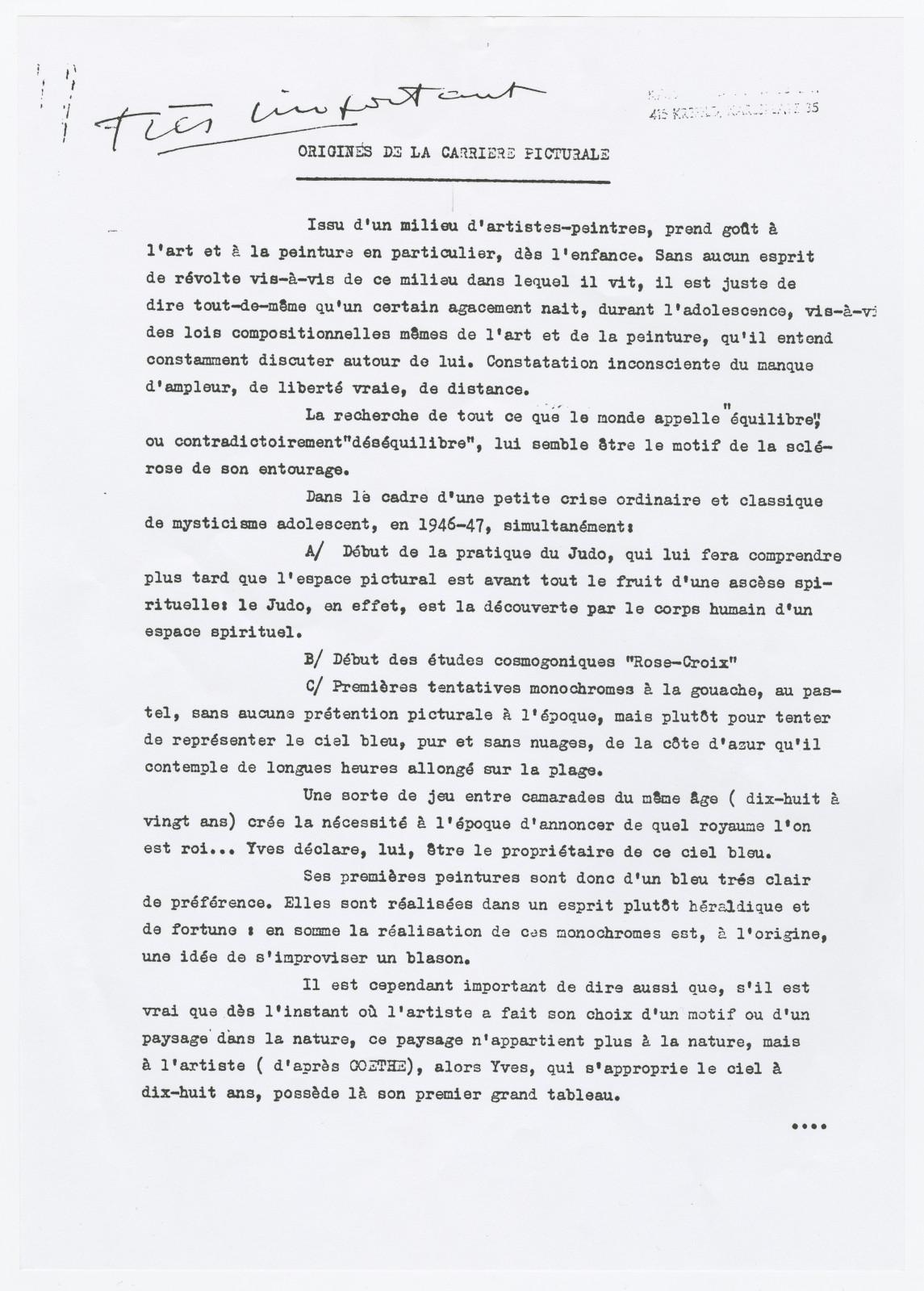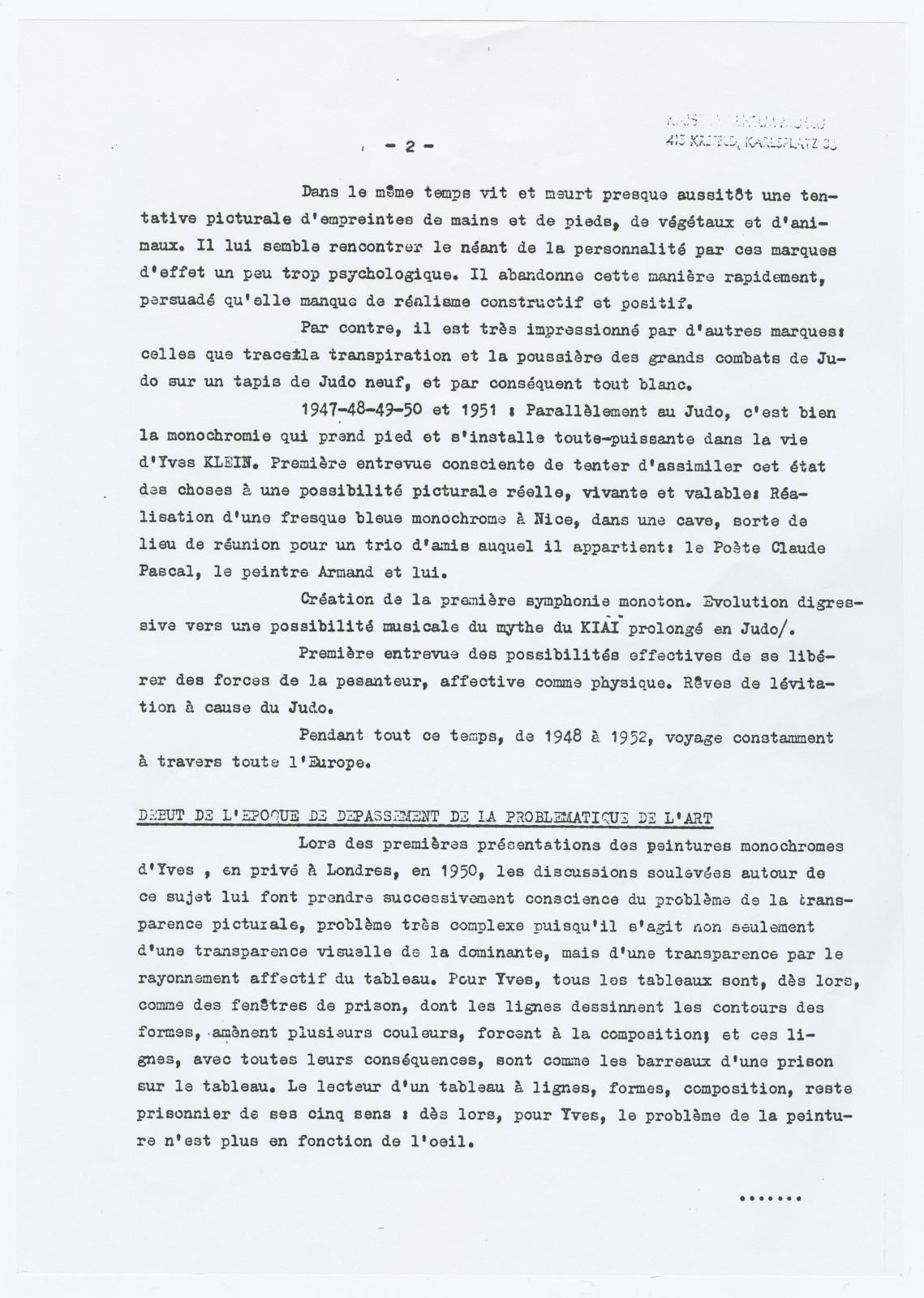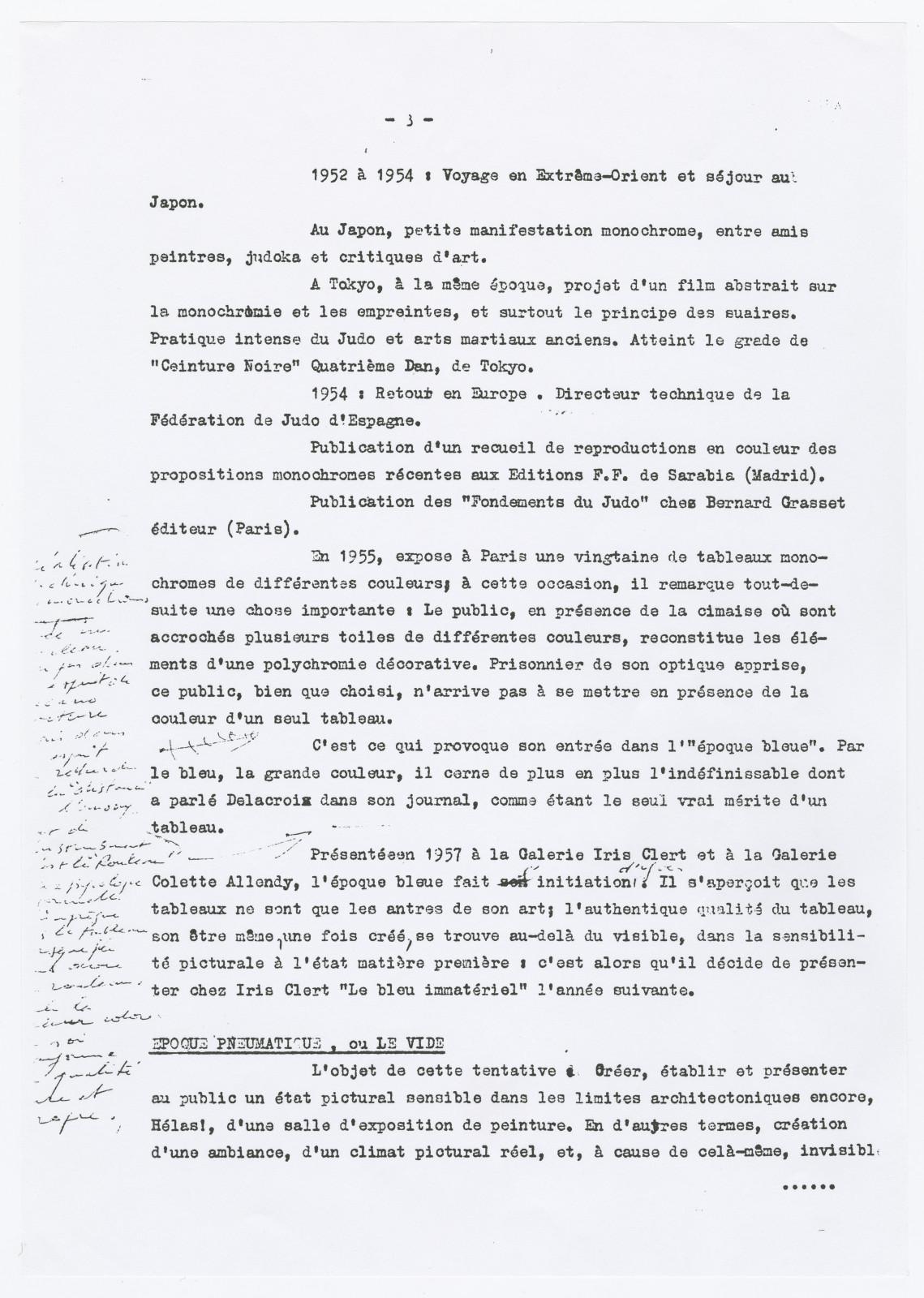Origins of his painting career
Born into a family of painters, he developed a taste for art and painting in particular from childhood. Without in any way rebelling against the environment in which he lived, it is fair to say that, during adolescence, he became somewhat annoyed with the very compositional laws of art and painting that he was constantly hearing discussed around him. An unconscious realisation of the lack of breadth, true freedom and distance.
The search for what everyone calls "balance", or contradictorily "imbalance", seems to him to be the reason for the sclerosis of those around him.
In the context of an ordinary, classic little crisis of adolescent mysticism, in 19461947, simultaneously:
A/ He began practising judo, which would later lead him to understand that pictorial space is above all the fruit of spiritual asceticism: judo, in fact, is the human body's discovery of a spiritual space.
B/ Beginning of Rosicrucian cosmogonic studies.
C/ First monochrome attempts in gouache and pastel, with no pictorial pretensions at the time, but rather an attempt to represent the pure, cloudless blue sky of the Côte d'Azur, which he contemplated for long hours stretched out on the beach.
A sort of game between friends of the same age (eighteen to twenty) created the need at the time to announce whose kingdom you were king of... Yves himself declared that he was the owner of this blue sky.
His first paintings were therefore preferably very light blue. They were done in a rather heraldic and fortune-making spirit: in short, the creation of these monochromes was originally an idea to improvise a coat of arms.
However, it is also important to say that, if it is true that once the artist has chosen a motif or landscape from nature, that landscape no longer belongs to nature, but to the artist (according to Goethe), then Yves, who made the sky his own at the age of eighteen, had his first great painting.
At the same time, a pictorial trend of hand and footprints, plant and animal prints lived and died almost immediately. It seemed to him that the nothingness of his personality was brought out by these marks, which were a little too psychological in their effect. He quickly abandoned this style, convinced that it lacked constructive and positive realism.
On the other hand, he was very impressed by other marks: those traced by the perspiration and dust of the great Judo fights on a new, and therefore all-white, Judo mat.
1947 48 49 and 1951: in parallel with Judo, monochromy took root and became omnipotent in Yves Klein's life. The first conscious attempt to assimilate this state of affairs into a real, living and valid pictorial possibility. Creation of a monochrome blue fresco in Nice, in a cellar, a sort of meeting place for a trio of friends to which he belonged: the pœ̀te Claude Pascal, the painter Arman and himself.
Creation of the first monoton symphony. Digressive evolution towards a musical possibility of the Kiai myth extended into Judo.
First glimpse of the real possibility of freeing oneself from the forces of gravity, both emotional and physical. Dreams of levitation because of Judo. During this time, from 1948 to 1952, travels constantly throughout Europe.
Beginning of the period of overcoming the problematic of art
During the first private presentations of Yves's monochrome paintings in London in 1950, the discussions that arose around this subject made him increasingly aware of the problem of pictorial transparency, a highly complex problem since it involved not only the visual transparency of the dominant colour, but also transparency through the emotional radiance of the painting. For Yves, all paintings are like prison windows whose lines draw the contours of shapes, bring in several colours and force composition; and these lines, with all their consequences, are like the bars of a prison on the painting. The reader of a painting with lines, shapes and composition remains a prisoner of his five senses: from then on, for Yves, the problem of painting was no longer a function of the eye.
1952 to 1954: travels to the Far East and stays in Japan.
In Japan, a small monochrome demonstration between painter friends, judoka and art critics.
At the same time, in Tokyo, project for an abstract film on monochromy and prints, and above all the principle of shrouds.
Intense practice of Judo and ancient martial arts. Achieves the rank of "Black Belt", fourth Dan, in Tokyo.
1954: returns to Europe. Technical director of the Spanish Judo Federation.
Publication of a collection of colour reproductions of recent monochrome proposals by Éditions F. de Sarabia (Madrid).
Publication of Fondements du Judo by Bernard Grasset éditeur (Paris).
In 1955, exhibits some twenty monochrome paintings in different colours in Paris; on this occasion, he immediately notices something important: the public, in the presence of a picture rail on which several paintings of different colours are hung, reconstitutes the elements of a decorative polychromy. Prisoners of their learned perspective, this audience, though chosen, is unable to come to terms with the colour of a single painting.
This marked his entry into the "blue period". Through blue, the great colour, he increasingly identified the indefinable, which Delacroix spoke of in his diary as the only true merit of a painting.
Technical realisation of monochromes with a roller, not in a spirit of mecano-instruction but in a spirit of seeking "distance" through the anonymity of the instrument that is the "roller". My personal psychology does not permeate the painting when I paint with a roller. Only the coloured value itself radiates pure, clean quality2.
Presented in 1957 at the Galerie Iris Clert and the Galerie Colette Allendy, l'époque bleue was Yves's initiation. He realised that the paintings were merely the ashes of his art; the authentic quality of the painting, its very being, once created, lay beyond the visible, in pictorial sensibility in its raw material state: it was then that he decided to present "Le bleu immatériel" at Iris Clert the following year.
Pneumatic period, or the void
The object of this attempt: to create, establish and present to the public a sensitive pictorial state within the still, alas, architectural confines of a painting exhibition room. In other words, to create an atmosphere, a pictorial climate that is real and, because of that very fact, invisible.
The general idea is to make the void our own. Back to bartering for the sale of these immaterial objects: Yves refuses money and demands pure gold. Matter for immateriality!
In order to situate his immaterial beyond all architectural or other limits, between even freer zones of pictorial sensitivity, Yves declared at the Sorbonne in 1959: "First, there is nothing... Then there is a deep nothing... then a blue depth" (after Gaston Bachelard).
1958: Robert Godet demonstrates the first research into prints with models: the principle of the living brush. An attempt to solve the problem of distance. The living brush solves the problem of distance even better than the roller. Forms reappear [?] already [?] transcended by the all-powerful anonymity, broken down into primary and essential vital states3.
1957 58: this evolution towards the immaterial gave rise to the architecture and urban planning of air, in collaboration with the architect Ruhnau, with whom he worked for two years on the construction of the new Opera House in Gelsenkirchen (Ruhr).
The immaterialisation of architecture is underway. That's a fact. And the very principle of using new materials for a truly dynamic and immaterial architecture is important. Pulsed air forms protective screens that form roofs. Air thus becomes a building material.
The use of water and fire as extrovert, urban decorative elements, to further link exterior and interior.
Idea of air conditioning entire regions. Conference at the Sorbonne in June 1959.
In December 1959, the work at Gelsenkirchen was completed. Yves Klein immediately resumed his pictorial research using prints.
Event: Anthropométrie de l'époque bleue, March 1960.
April 1960: Cosmogonies. Production of paintings with the help of atmospheric manifestations such as rain, wind or lightning.
"He who does not believe in miracles is not a realist" (Ben Gourion). The monochrome path is pure enthusiasm. It shows a clear path towards man's true freedom in nature and space.
Born into a family of painters, he developed a taste for art and painting in particular from childhood. Without in any way rebelling against the environment in which he lived, it is fair to say that, during adolescence, he became somewhat annoyed with the very compositional laws of art and painting that he was constantly hearing discussed around him. An unconscious realisation of the lack of breadth, true freedom and distance.
The search for what everyone calls "balance", or contradictorily "imbalance", seems to him to be the reason for the sclerosis of those around him.
In the context of an ordinary, classic little crisis of adolescent mysticism, in 19461947, simultaneously:
A/ He began practising judo, which would later lead him to understand that pictorial space is above all the fruit of spiritual asceticism: judo, in fact, is the human body's discovery of a spiritual space.
B/ Beginning of Rosicrucian cosmogonic studies.
C/ First monochrome attempts in gouache and pastel, with no pictorial pretensions at the time, but rather an attempt to represent the pure, cloudless blue sky of the Côte d'Azur, which he contemplated for long hours stretched out on the beach.
A sort of game between friends of the same age (eighteen to twenty) created the need at the time to announce whose kingdom you were king of... Yves himself declared that he was the owner of this blue sky.
His first paintings were therefore preferably very light blue. They were done in a rather heraldic and fortune-making spirit: in short, the creation of these monochromes was originally an idea to improvise a coat of arms.
However, it is also important to say that, if it is true that once the artist has chosen a motif or landscape from nature, that landscape no longer belongs to nature, but to the artist (according to Goethe), then Yves, who made the sky his own at the age of eighteen, had his first great painting.
At the same time, a pictorial trend of hand and footprints, plant and animal prints lived and died almost immediately. It seemed to him that the nothingness of his personality was brought out by these marks, which were a little too psychological in their effect. He quickly abandoned this style, convinced that it lacked constructive and positive realism.
On the other hand, he was very impressed by other marks: those traced by the perspiration and dust of the great Judo fights on a new, and therefore all-white, Judo mat.
1947 48 49 and 1951: in parallel with Judo, monochromy took root and became omnipotent in Yves Klein's life. The first conscious attempt to assimilate this state of affairs into a real, living and valid pictorial possibility. Creation of a monochrome blue fresco in Nice, in a cellar, a sort of meeting place for a trio of friends to which he belonged: the pœ̀te Claude Pascal, the painter Arman and himself.
Creation of the first monoton symphony. Digressive evolution towards a musical possibility of the Kiai myth extended into Judo.
First glimpse of the real possibility of freeing oneself from the forces of gravity, both emotional and physical. Dreams of levitation because of Judo. During this time, from 1948 to 1952, travels constantly throughout Europe.
Beginning of the period of overcoming the problematic of art
During the first private presentations of Yves's monochrome paintings in London in 1950, the discussions that arose around this subject made him increasingly aware of the problem of pictorial transparency, a highly complex problem since it involved not only the visual transparency of the dominant colour, but also transparency through the emotional radiance of the painting. For Yves, all paintings are like prison windows whose lines draw the contours of shapes, bring in several colours and force composition; and these lines, with all their consequences, are like the bars of a prison on the painting. The reader of a painting with lines, shapes and composition remains a prisoner of his five senses: from then on, for Yves, the problem of painting was no longer a function of the eye.
1952 to 1954: travels to the Far East and stays in Japan.
In Japan, a small monochrome demonstration between painter friends, judoka and art critics.
At the same time, in Tokyo, project for an abstract film on monochromy and prints, and above all the principle of shrouds.
Intense practice of Judo and ancient martial arts. Achieves the rank of "Black Belt", fourth Dan, in Tokyo.
1954: returns to Europe. Technical director of the Spanish Judo Federation.
Publication of a collection of colour reproductions of recent monochrome proposals by Éditions F. de Sarabia (Madrid).
Publication of Fondements du Judo by Bernard Grasset éditeur (Paris).
In 1955, exhibits some twenty monochrome paintings in different colours in Paris; on this occasion, he immediately notices something important: the public, in the presence of a picture rail on which several paintings of different colours are hung, reconstitutes the elements of a decorative polychromy. Prisoners of their learned perspective, this audience, though chosen, is unable to come to terms with the colour of a single painting.
This marked his entry into the "blue period". Through blue, the great colour, he increasingly identified the indefinable, which Delacroix spoke of in his diary as the only true merit of a painting.
Technical realisation of monochromes with a roller, not in a spirit of mecano-instruction but in a spirit of seeking "distance" through the anonymity of the instrument that is the "roller". My personal psychology does not permeate the painting when I paint with a roller. Only the coloured value itself radiates pure, clean quality2.
Presented in 1957 at the Galerie Iris Clert and the Galerie Colette Allendy, l'époque bleue was Yves's initiation. He realised that the paintings were merely the ashes of his art; the authentic quality of the painting, its very being, once created, lay beyond the visible, in pictorial sensibility in its raw material state: it was then that he decided to present "Le bleu immatériel" at Iris Clert the following year.
Pneumatic period, or the void
The object of this attempt: to create, establish and present to the public a sensitive pictorial state within the still, alas, architectural confines of a painting exhibition room. In other words, to create an atmosphere, a pictorial climate that is real and, because of that very fact, invisible.
The general idea is to make the void our own. Back to bartering for the sale of these immaterial objects: Yves refuses money and demands pure gold. Matter for immateriality!
In order to situate his immaterial beyond all architectural or other limits, between even freer zones of pictorial sensitivity, Yves declared at the Sorbonne in 1959: "First, there is nothing... Then there is a deep nothing... then a blue depth" (after Gaston Bachelard).
1958: Robert Godet demonstrates the first research into prints with models: the principle of the living brush. An attempt to solve the problem of distance. The living brush solves the problem of distance even better than the roller. Forms reappear [?] already [?] transcended by the all-powerful anonymity, broken down into primary and essential vital states3.
1957 58: this evolution towards the immaterial gave rise to the architecture and urban planning of air, in collaboration with the architect Ruhnau, with whom he worked for two years on the construction of the new Opera House in Gelsenkirchen (Ruhr).
The immaterialisation of architecture is underway. That's a fact. And the very principle of using new materials for a truly dynamic and immaterial architecture is important. Pulsed air forms protective screens that form roofs. Air thus becomes a building material.
The use of water and fire as extrovert, urban decorative elements, to further link exterior and interior.
Idea of air conditioning entire regions. Conference at the Sorbonne in June 1959.
In December 1959, the work at Gelsenkirchen was completed. Yves Klein immediately resumed his pictorial research using prints.
Event: Anthropométrie de l'époque bleue, March 1960.
April 1960: Cosmogonies. Production of paintings with the help of atmospheric manifestations such as rain, wind or lightning.
"He who does not believe in miracles is not a realist" (Ben Gourion). The monochrome path is pure enthusiasm. It shows a clear path towards man's true freedom in nature and space.
| Technical | Photocopie |


